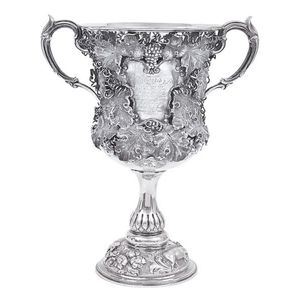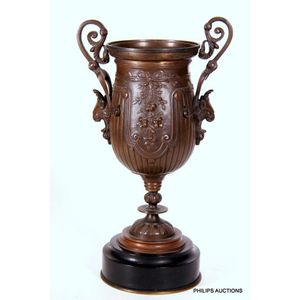Victorian Floral Etched Sterling Silver Jug, Birmingham 1863
You must be a subscriber, and be logged in to view price and dealer details.
Subscribe Now to view actual auction price for this item
When you subscribe, you have the option of setting the currency in which to display prices to $Au, $US, $NZ or Stg.
- Hallmarks - A mark stamped on articles of precious metals in Britain, since the 14th century, certifying their purity. It derives its name from the Guild Hall of the Goldsmiths' Company, who recieved its Charter in 1327 giving it the power to assay (test the purity) and mark articles of gold and silver.
The hallmark will consist of several marks, including the:
- silver standard mark, indicating the purity of the metal. Sterling silver is .925 pure silver.
- the city mark indicating the city in which it was assayed eg London, Birmingham, York etc.
- the date mark, usually a letter of the alphabet in a particular font and case,
- a duty mark, indicating whether duty had been paid to the crown, and only in use from 1784 to 1890
The piece may include an additional mark, the maker's mark, although not forming part of the hallmark, will be located in the vicinity of the hallmarks.
Sometimes silver plated items will bear faux hallmarks, often confusing those not familiar with silver markings. - Victorian Period - The Victorian period of furniture and decorative arts design covers the reign of Queen Victoria from 1837 to 1901. There was not one dominant style of furniture in the Victorian period. Designers used and modified many historical styles such as Gothic, Tudor, Elizabethan, English Rococo, Neoclassical and others, although use of some styles, such as English Rococo and Gothic tended to dominate the furniture manufacture of the period.
The Victorian period was preceded by the Regency and William IV periods, and followed by the Edwardian period, named for Edward VII (1841 ? 1910) who was King of the United Kingdom and the British Dominions and Emperor of India for the brief period from 1901 until his death in 1910. - Sterling Silver - Sterling silver is a mixture of 92.5% pure silver and 7.5% of another metal, usually copper. Fine silver is 99.9% pure silver, and is relatively soft and the addition of the very small amount of copper gives the metal enough strength and hardness to be worked into jewellery, decorative and household objects.
This item has been included into following indexes:
Visually similar items

The 1862, Geelong District Wine Growers sterling silver cup and Australian silver collar the collar attributed to Louis Kitz, (1820-1887), Geelong; the cup with maker's mark Daniel and Charles Houle, London, circa 1859, the two handled cup with an ogee bod

A French bronze urn, 19th century, a bell shaped urn with high set bifurcated scrolling handles with roaring lion mounts, the reeded body with shaped panels enclosing pendant floral festoons, above a knopped and turned stem to a spreading black marble base

English hallmarked sterling silver Victorian Christening mug having a round hand-chased body with floral and scroll-work decoration, an elaborate scrolled handle, sitting on a raised floral pedestal foot, London, 1863, maker Chawner & Co, height 10.7 cm, w

A George III sterling silver floral cream jug by Nathaniel Appleton & Ann Smith, London 1779 10 cm high, 75grams
